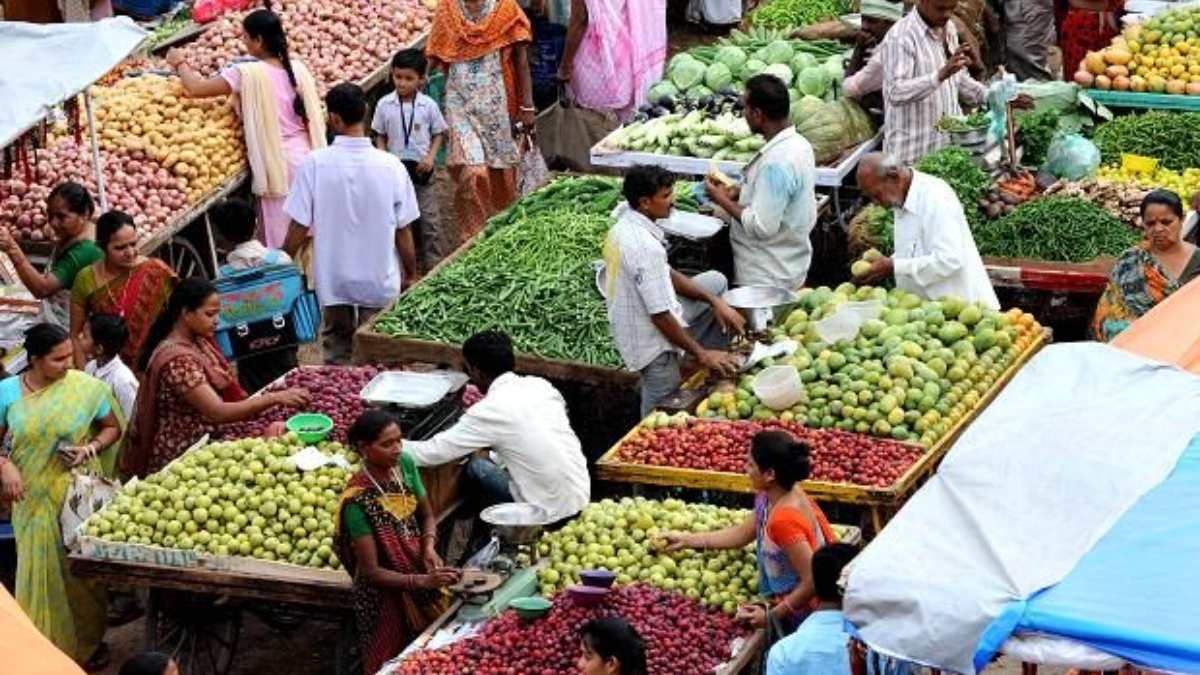
‘Fragmentation’ is perhaps the single most dreaded concept in India’s agricultural economy and yet “fragmentated” is the oft-quoted adjective employed to define the Indian agricultural market. Despite record shattering grain production year-on-year and an almost assembly line rollout of welfare schemes, the primary economic sector along with the primary producer has spectacularly failed at upending the continuous fall in marginal productivity and output. Multiple systemic ills associated with lack of research, absent mechanisation, patchy irrigation, credit availability and tightly controlled procurement and marketing continue to plague the farm sector.
Treatises have been and shall continue to be written on each of the above, yet to summarily encapsulate the extent of the issue one must stare at the starkness of the fall of primary sector’s contribution to the national income (Gross Value Added) from 18.2% in 2014-15 to 16.5% in 2019-20 while continuing to be the single largest source of livelihood in our country with more than 70% rural households still depending on the agri-sector for sustenance. In fact, the fall in share of the primary sector goes directly against the mission of this government to double farmers’ incomes by 2022.
The woeful condition as above is a direct function of low rates of farm mechanisation, unwarranted government market intervention, poorly directed farm credit programmes, unplanned trade shocks implemented in the form of sudden restrictions on exports, restricted market access, undeveloped food processing and allied sectors such as fisheries, animal husbandry and dairy. In fact the latest Economic Survey 2019-20 skilfully encapsulates the root of the issue as below;
“4.20. In the grain markets in India, Government has sought to achieve food security while ensuring remunerative prices to producers and safeguarding the interest of consumers by making supplies available at affordable prices. In trying to achieve this, the state controls input prices such as those of fertilizer, water, and electricity, sets output prices, undertakes storage and procurement through an administrative machinery, and distributes cereals across the country through the PDS.” [‘Undermining Markets: When Government Intervention Hurts More than it Helps’, The Economic Survey 2019-20 (Vol-I, p. 82)
Evidently thus, it cannot be anyone’s case that the powers that be remain unaware of the ills that face our agri-markets. Interestingly, the lowest hanging fruit towards long-standing reform has always been related to procurement and marketing practices and yet it is here that the legislative noose has for most of India’s post-independence history been firmly constrictive. In fact, the constitutive states of the Union of India, drawing upon their constitutional mandate to legislate unto “Agriculture, including agricultural education and research, protection against pests and prevention of plant diseases” [See Entry 14, State List (List-II), 7th Schedule to the Constitution of India], have enacted their own laws thereby giving birth to the Agricultural Produce Marketing Committee (APMC), archetypally referred to as the ‘mandi’. The APMC or the mandi thus became the first point of sale for notified produce ranging from cereals to pulses to vegetables as well as meat, poultry and fisheries.
CASCADING LEVIES AND ARTIFICIAL CONTROLS
Though the APMC does to an extent assist in price discovery, the multiplicity of taxes/fees/cesses/levies at every step of the process manifest themselves into cascading prices. The result is that an inflationary trend in retail prices ensues whereas the benefit to the producer, i.e. the farmer is nominal. The most damaging aspect of the APMC mandi hegemony is the legislatively imposed monopsony. Furthermore, the presence of almost 2500 geographically divided APMCs and approximately 5000 sub-markets drastically skews the entire operation of procurement and marketing into fragmented silos that doesn’t lend itself to actual price discovery owing to severe geographical limitations.
An already distorted and disjointed market has for decades further been undermined by artificial stock limits vide the draconian Essential Commodities Act, 1955 (ECA) and even though its inefficacy has been outlined by time and again, it continues to stifle the agricultural economy of India. Coupled with the various state APMC laws, the ECA gives almost unbridled power to the state governments to impose stifling and often ill- timed, ill-judged and ill-fated control orders resulting in severe restrictions on stocking limits and inter-state movement of goods along with the grant of draconian powers of seizure and penalties in case of non-compliance. As has aptly been outlined by the Economic Adviser to the Government of India, many if not most of the market distortions in the realm of agri-markets are a direct result of the ECA induced market disruptions, undermining of storage and warehousing and the resultant non-development of food processing industries.
E-NAM TOWARDS FARMERS’ LIBERATION
The policy makers in the Department of Economic Affairs (Ministry of Finance), being acutely aware of the plethora of issues emanating from the APMC mandi system, sought to remedy the same by introducing the e- National Agricultural Market (e-NAM) during the central government’s first term in office. The goal was to gear the agricultural economy of India towards open market trading and in consonance with that the vision of breaking the APMC/mandi stranglehold was succinctly laid out in the Economic Survey 2014-2015;
“The 2014 budget recognizes the need for setting up a national market and stated that the central government will work closely with the state governments to reorient their respective APMC Acts to provide for the establishment of private market yards/private markets. The budget also announced that the state governments will also be encouraged to develop farmers” markets in towns to enable farmers to sell their produce directly.” [‘A National Market for Agricultural Commodities – Some Issues and the Way Forward’, The Economic Survey 2014-15 (Vol-I, p. 126)]
As the name suggests, e-NAM was intended to connect the mandis across the country and develop an online marketing platform. However since the same was predicated upon states’ participation in the project, it had a limited reach which reflects in the fact that only ‘585 wholesale regulated markets in 16 States and 2 UTs having connected to e-NAM” [‘Thalinomics: The Economics of a Plate of Food in India’, The Economic Survey 2019-20 (Vol-I,p. 276)], till date.
Since its launch in April 2016, the e-NAM has seen low to moderate trade on its platform and by no stretch of imagination was it a panacea for the ills facing the linkages between farmers and consumers/buyers. As outlined above, the state APMC participation was tepid at best and issues surrounding infrastructure, connectivity and lack of familiarity translated into continuing hegemony of the traditional mandi system. The new e- trading platform was merely a collectivisation over electronic means of the existing mandis; evidently the reliance upon the APMC was as prevalent as ever. Despite the reformative outlook, the e-NAM system still enjoined the farmers to bring their produce to the local mandi for finding prospective buyers and thus the mandis continued to hold substantial sway. The goal, therefore, of a unified national market for agricultural produce remains woefully unrealised.
LEGISLATIVE COURSE CORRECTION
It is here that the central government, following up on the Finance Minister’s announcement, promulgated three crucial pieces of legislation on 5 June 2020; the Farmers’ Produce Trade and Commerce (Promotion and Facilitation) Ordinance, 2020 (hereinafter ‘Produce Trade Ordinance’); the Farmers (Empowerment and Protection) Agreement on Price Assurance and Farm Services Ordinance, 2020 (hereinafter ‘Price Assurance Ordinance’); and the Essential Commodities (Amendment) Ordinance, 2020 (hereinafter ‘ECA Ordinance’). The goal was not only to dismantle the APMC hegemony and ECA distortions, but to further deliver tangible reforms in agricultural production, procurement and marketing with both the Produce Trade Ordinance and the Price Assurance Ordinance primed towards disentangling the farmer and his produce from the monopsonistic mandi model.
Notably, the Produce Trade Ordinance firmly establishes the ‘freedom to conduct trade and commerce in a trade area’ along with granting freedom to engage in inter-State trade or intra-State trade of scheduled farmers’ produce” [Section 3 and 4, Produce Trade Ordinance]. In fact, the concerned ordinance goes so far as to exempt the ‘scheduled farmers’ produce’ [Section 2(j)] from the excessive market fee, cess and levies charged by the APMC in the usual course of business [Section 6]. This ordinance is also a break away from the e-NAM for it doesn’t resign e-trading of farmers’ produce to the mandi set up. In fact, electronic trading platforms can be established by any “person” (not being an individual), “farmer producer organization” or “agricultural cooperative society” [Section 5].
While the above legislation aims to break the physical and geographical constraints of the APMC mandi, the Price Assurance Ordinance is a step towards ensuring marketability of the farmers’ produce via, primarily, contract farming. The foremost step was to ensure that the mandi no longer remains the first point of sale and in line with that ‘farming produce’ [See Section 2(a); The Farmers (Empowerment and Protection) Agreement on Price Assurance and Farm Services Ordinance, 2020] was „exempted from the application of any State Act…established for the purpose of regulation of sale and purchase of such farming produce’ [Section 7]. In furtherance of its stated objective, the said ordinance lays out the broad contours and associated safeguards and is perched on three pillars being the producer, i.e. the “farmer”; the purchaser, i.e. the “sponsor”; and the pre-production pact between them outlining the farming produce, its quality and quantity along with the associated “farm services” to be provided by the concerned sponsor, i.e. the “farming agreement” [Sections 2(e), (f), (h) & (o)]
At the same time, while the said promulgations by way of Ordinance(s) directs towards a promising and effective market to the farmers, nevertheless, the predicament to end the existing system of government grain procurement at Minimum Support Prices (‘MSP’) still looks beyond reach. This directly point towards an obvious narration that while the Ordinance attempts to mark Centre’s exit from the procurement of farm yields, at the same time, it gives equal monopoly to the state government to regulate the same by earning substantial money from various levies on the value of produce transacted in APMCs. For instance, Punjab’s annual revenues from mandi fees and ‘rural development’ cess – which adds up to 6% on paddy and wheat, 4% on basmati and 2% on cotton and maize – are estimated at Rs. 3500-3600 crores [see The Indian Express, ‘Three Ordinances and a protest – Why are Haryana and Punjab farmers angry?’ (12.09.2020)], which will definitely get hit if trades were to move from the APMC mandis.
A critical perusal of the Ordinances highlights that although the massive reforms were necessary as a part of the COVID relief package, the new laws have far-reaching implications, not just from legal but also socio-economic point of view, which cannot be unheeded at any cost.
Given a liberal trade environment to the farmers’ to trade outside APMC mandi, only on the strength of PAN card [Section 5: Produce Trade Ordinance], it is equally necessary for the state government to keep a tab on private stocks. This is easily achievable by making the registration of warehouses mandatory with the Warehousing (Development and Regulation) Act, 2007 (hereinafter referred to as ‘Act of 2007’). Under the said Act, there is already a provision of issue of electronic warehousing receipt [Section 2 (m), 2(u) r/w Chapter IV, Section 11-15, Act of 2007]. The same can also be used to keep a track on the limit of stock available and the same can even be used to raise loans.
SIDESTEPPING THE STATES ON FARM REFORMS
The APMC mandi reforms via the e-NAM mode were from the very beginning predicated upon each state ensuring that certain prerequisites were met; ‘(i) a single license to be valid across the state, (ii) single point levy of market fee and (iii) provision for electronic auction as a mode for price discovery.’ [‘Prices, Agriculture and Food Management’, The Economic Survey 2015-16 (Vol-II, p. 120)]. However, with promulgation of the above ordinances, the government of the day has effectively sidestepped its reliance on states and their perceived ineptness in failing to reform and given an impetus to farm deregulation and privatisation.
Further, with the coming in of the ECA Ordinance which in effect limits the draconian measures of the Essential Commodities Act, 1955 to ‘extraordinary circumstances which may include war, famine, extraordinary price rise and natural calamity of grave nature’, [Section 2; The Essential Commodities (Amendment) Ordinance, 2020] the resolve to walk the talk on ensuring deregulated farmlands and integrated markets must be seen to be real and robust.
The measures taken here are surely far from perfect, in fact the central government has failed to look into a major reason for the failure of the e- NAM scheme, i.e. assaying and grading of produce. Towards the same, while the Price Assurance Ordinance leaves it to the farming agreement between the farmer and the sponsor, the Produce Trade Ordinance provides that the central government may prescribe modalities in that regard and thus it’s a possibility that rules and regulations will be prescribed sooner than later.
Though the said move by the Centre may be termed as an ‘historic agriculture development’, yet, considering the recent protests by farmers across Punjab and Haryana, one cannot overlook the fact that prima facie, the intent of the Ordinances seems to have inclination towards agri-business and not towards the security of farmers. At present, farmers in India needs exclusive state-supported schemes so as to ensure that the farmers are being adequately paid for damaged crops during any calamities or may even get minimum subsidies from the state government. This is also because considering how farmers are vulnerable and susceptible; it would be a massive challenge for them to enter into contracts with large corporates, owing to unequal interface with the market.
Even legally, as per the Constitution of India, Entry 14 of List II comprises agriculture as the subject of the state. Therefore, the three ordinances passed by the Centre are in violation of the Constitution of India as also, these ordinances are a direct encroachment upon the functions of the states and are against the spirit of co-operative federalism enshrined therein. This is also alarming as considering the ECA Ordinance, the Centre by taking the Ordinance route, had bypassed the parliamentary process. It is because when a proposed amendment is introduced in Parliament, the said subject is open to debate, scrutiny, comments and inputs from all the stakeholders.
Considering the overall scheme of the ordinances and the Amendment Act, it is clear that the same provides for regulation only in extraordinary circumstances which ideally may include any grave calamity, be it natural or man-made. Since the said expression is not defined anywhere in the Amendment Act, the pre-conditions of price rise of perishable and non- perishable goods will be frequently met even in remote situations of failure of monsoon (as in 2014-15 or 2015-16) or even excessive rains (as for soyabean in 2019-20) or pest attack (as in case of the Fall Armyworm attack on maize in 2019-20) [see The Wire, ‘The Fine Print of the Essential Commodities Act Ordinance Must be Carefully Parsed’ (22.06.2020)].
Needless to say, the said policies ought to have ensured sustainable farm growth taking into consideration the factors like climate change, land holdings, farmers’ interests and consumer capacity. India is still dependent on monsoon for producing sufficient food grains and majority of farm holding in India is small and marginal. In light of these factors, the accountability and effectiveness at each level ought to be balanced so as to expect fruitful outcome.
Another important aspect that necessitates comprehensive re-assessment is that a lot more clarity is needed on the management of food stocks as the Centre/State government do not have the requisite data so as to keep track of the stocks being held by private sectors. For centrally pooled stocks, the data is well within the public domain and the same is managed through computerized stock management system of the Food Corporation of India. However, no such system exists for privately held stocks. While the removal of restrictions on trading through Produce Trade Ordinance is a welcome step for the agriculture sector, the government should procure more information on private trade viz., demand of a commodity, stocks being held up by the private sectors and the estimated production vis-à-vis desired availability of stock.
In conclusion, it must be put forth that regardless of the above legislations coming about as a direct result of pandemic induced privations, the hope and assumption is that resumption of Parliamentary processes will only further endure the reforms brought about herein.
The new e-trading platform was merely a collectivisation over electronic means of the existing mandis; evidently the reliance upon the APMC was as prevalent as ever. Despite the reformative outlook, the e-NAM system still enjoined the farmers to bring their produce to the local mandi for finding prospective buyers and thus the mandis continued to hold substantial sway. The goal, therefore, of a unified national market for agricultural produce remains woefully unrealised.














